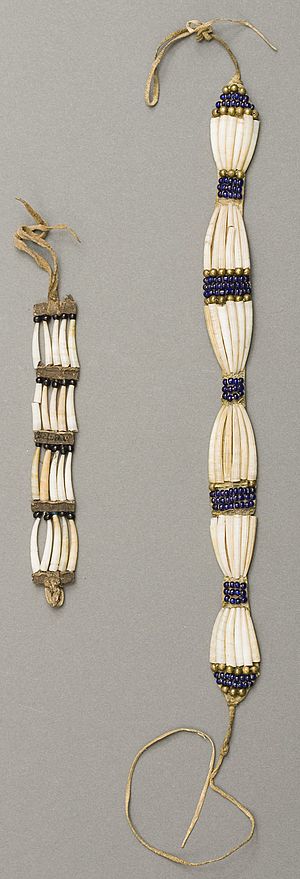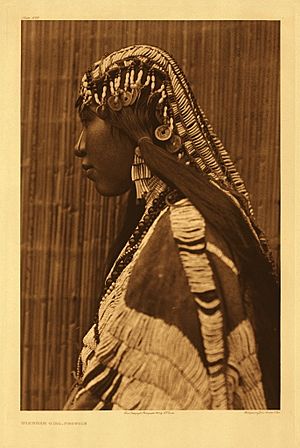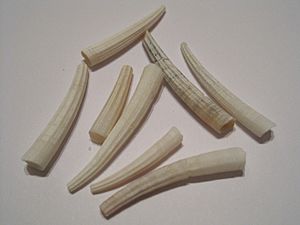Dentalium shell facts for kids

The word dentalium usually refers to special tooth-shaped or tusk-shaped shells. These shells were very important to Native American and First Nations people. They used them for jewelry, decorations, and trading across western Canada and the United States.
These tusk shells are a type of seashell. They come from small sea creatures called scaphopod mollusks. The name "dentalium" comes from the scientific name for a group of these shells, Dentalium. Even though scientists have changed how they classify some shells, all the shells used are still in the same family, Dentaliidae.
Dentalium shells were traded far and wide by Inuit, First Nations, and Native Americans. This trade happened along the western coast of Canada and the Pacific Ocean coast of the northwest United States, reaching down to Southern California. The shells of Antalis pretiosa were especially valued. These "precious dentalium" shells were gathered from deep waters off the Pacific Northwest coast of North America, especially near Vancouver Island. Today, many dentalium shells sold are smaller and come from coasts off Asia.
Contents
How Dentalium Shells Were Used
Pacific Northwest

People from the Northwest Pacific Coast traded dentalium shells to many other areas. These areas included the Great Plains, Great Basin, Central Canada, the Northern Plateau, and Alaska. In return, they received items like food, decorations, dyes, animal hides, and even bright macaw feathers from Central America. They also traded for turquoise from the American Southwest.
The Nuu-chah-nulth people were the main ones who gathered dentalium shells. For tribes along the Northwest Coast, these shells were valuable for both trade and decoration. Young Nuu-chah-nulth girls from important families wore fancy dentalium jewelry. When a girl's jewelry was removed, a special celebration called a potlatch was held. After this, the girl was considered ready for marriage.
Athabaskan people in Alaska and northern Canada also used dentalium. They often combined the shells with glass beads to make jewelry. In the 1800s, these items were seen as important and valuable trade goods.
The shells of Antalis pretiosa from Vancouver Island were first traded to the Canadian Plateau region a very long time ago, between 1000 and 1 BCE. By the 1st century CE, these shells were a common trade item among the Plateau tribes. Some important women from Plateau tribes even wore dentalium shells through their pierced noses. Beautiful bridal headdresses from the 1800s and early 1900s featured dentalium shells. These were often strung on animal hide with Chinese brass coins and glass beads. The Nlaka'pamux people sometimes placed dentalium shells with their relatives in burials. The shells were also given away at memorial services.
California
Dentalium shells were very important to California tribes. The Yurok people have a story that a god named Pithváva, or "Big Dentalium," created the smaller dentalium shells. This god also decided how important they would be as sacred wealth. For tribes in northern California, dentalium was the most important way to trade goods. They used the shells in special clothing, for gambling, and for buying and selling things.
The value of a shell depended on its length and quality. The best shells were about 2.25 inches long. A dozen of these shells would often be strung together. A string of dentalium about 27.5 inches long could buy a large dugout canoe made from redwood. Some men, known as "Indian bankers," had special tattoos on their arms. They used these marks to measure the length of the shells. Tribes like the Yurok, Karuk, and Hupa kept their dentalium shells in special elk-antler purses or woven treasure baskets.
On the Central Coast of California, shells of Dentalium neohexagonum have been found at ancient sites. The Chumash people likely used these shells as tubes, possibly for jewelry.
Great Plains
Among Plains Indians, dentalium shells were a sign of wealth. They were used to decorate women's capes, the top parts of dresses, hair ornaments, necklaces, and long, hanging earrings.
Modern Uses
Today, dentalium shells are still used in traditional clothing and decorations by Native American and Inuit people.
Middle East
In ancient times, in a region called the Levant, dentalium shells were sometimes placed in burials. We are not sure exactly what they meant to the people who buried them.
See also
- Shell money
- Beadwork – Native American


